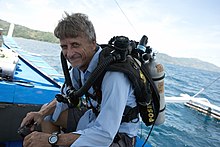Richard Pyle
Richard Pyle | |
|---|---|
 Richard L. Pyle on boat in Philippines, with Poseidon SE7EN Rebreather | |
| Born | |
| Nationality | Canadian |
| Education | Ph.D., Zoology |
| Alma mater | University of Hawaii at Manoa, Honolulu |
| Scientific career | |
| Fields | Marine biology |
| Institutions | Bishop Museum |
Richard L. Pyle, Ph.D. is a scuba diver and ichthyologist working on Hawaii. He was born on Hawaii.[1][2]
Pyle discovered the principle of "Pyle stops" when decompressing from many deep dives in search of new species of fish, and has identified hundreds of new species.[3][4]
He is the author of over 130 publications.[1]
In October 2015, he won second prize, an award of €5,000, in the GBIF Ebbe Nielsen Challenge, a Global Biodiversity Information Facility competition, for BioGUID.org, "a web service that crosslinks identifiers linked to data objects in the biodiversity realm".[5] At that time, the site contained over one billion (1,000,000,000) identifiers.[5]
References
- ^ a b "Hawaii Biological Survey Staff, Richard L. Pyle". Bishop Museum. 2009. Retrieved 6 April 2016.
- ^ Pyle, Richard. "Curriculum vitae, Richard L. Pyle, Department of Natural Sciences, Bishop Museum, Honolulu" (PDF). Retrieved 9 March 2016.
- ^ Pyle, Richard L. (1997). "The importance of deep safety stops: Rethinking ascent patterns from decompression dives". Journal of the South Pacific Underwater Medicine Society. South Pacific Underwater Medicine Society. Retrieved 9 March 2016.
- ^ "Richard Pyle". TED.com. Retrieved 6 April 2016.
- ^ a b "Winners named for first GBIF Ebbe Nielsen Challenge". Global Biodiversity Information Facility. 30 October 2015. Retrieved 30 June 2016.
